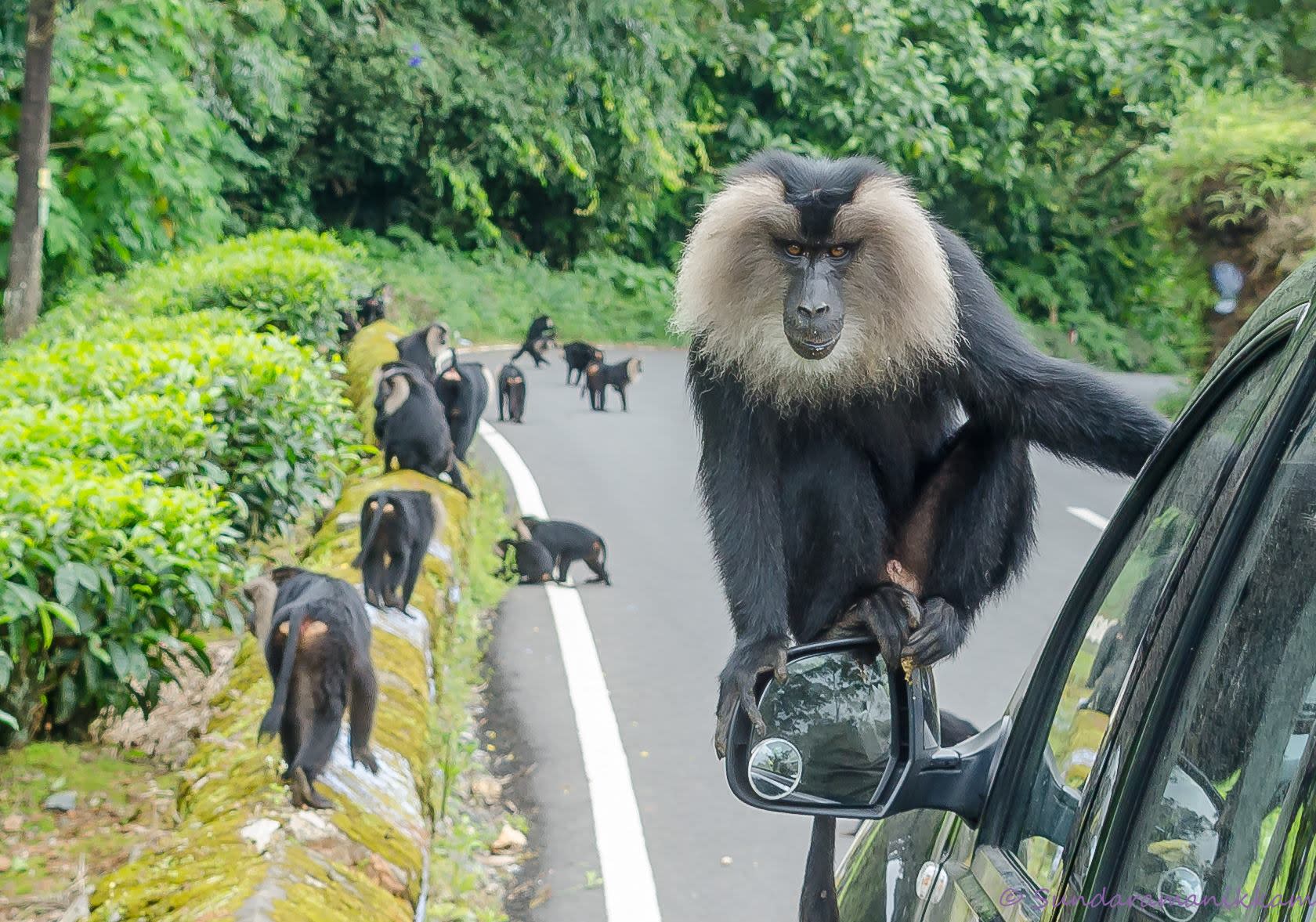 Listen to this article
•
15:34 min
Listen to this article
•
15:34 min
In the tropical rainforests of the Western Ghats lives a small population of black-bodied Old World monkeys called the lion-tailed macaque (LTM). Named for their silver-grey mane and tails that end in a tuft (like that of a lion), these monkeys were once exclusive tree-dwellers. They spend nearly all their time manoeuvring through the dense, high canopy, their native habitat. LTMs feed extensively on important rainforest tree species such as the wild durian (Cullenia exarillata), also endemic to the southern and central Western Ghats, and many species of fig (Ficus). As a result, they contribute significantly to the dispersal of rainforest trees and the survival of the rainforest itself. Today, the lion-tailed macaque is seriously threatened by expanding human activity, and they number under 4,000.
Since the early 1800s, the clearing of forests to create vast tea and coffee plantations resulted in large forest tracts becoming fragmented. Some of these fragments became further degraded due to continued human activity in and around them.

Cover photo: Roads passing through the lion-tailed macaque’s habitat in Valparai are forcing these once exclusive tree-dwellers to descend to ground level in search of food. Photo: VR Sundaramanikkam
One such forest fragment situated on the Valparai plateau, with an area of less than one sq. km is Puthuthottam. It has a highway passing through it, and houses a subpopulation of about 150 lion-tailed macaques. Here, the monkeys often encounter humans or habitations, plantations, roads, and even a town as they move in search of food. The road that passes through the forest fragment has created a gap in the canopy, hindering the movement of LTMs, and forcing them to descend to ground level to cross over. When on the ground, the LTMs are especially susceptible to being hit and killed by speeding vehicles.
To help address this specific threat of road accidents, an NGO called Nature Conservation Foundation, has installed canopy bridges or ladders made out of fire hose material. These are tied to trees on either side of the road at locations where the canopy gap is wide. These canopy bridges help LTMs cross safely, without having to face the challenging road below, where they risk their lives. Efforts by NCF have also led to the installation of speed breakers, again to reduce the chance of animals being run over. NCF also employs two members of the local community to act as ‘LTM watchers’. Part of their job is to hold up ‘GO SLOW’ signs to passing vehicles. As an outreach measure to spread awareness among the young, the foundation also runs monthly field and classroom sessions with school students to teach them about local wildlife (including the key species like the LTM), the threats they face, and conservation strategies.
LTMs who live in this anthropogenic habitat, i.e. an area influenced by human activity and habitation, also face another unseen threat. They have begun to show shifts in their dietary composition from rainforest plants to food that humans eat, including cooked and preserved foods. Human-use foods such as rice, chapatis, bread, etc. are tempting to monkeys, as they are often easily accessible where humans live, and thus allows them to reduce their foraging time significantly. Preserved and even cooked foods can, however, be unhealthy for them, or contain toxicants. A harmful food item can contain a particle that causes dysfunction in the animal’s biological system. Chemicals and preservatives, or nutrients inherent in the food may be unsuitable. Or they could consume foods shown to cause disease and digestive disorders in other primate species. Additionally, monkeys often scour garbage dumps for food, increasing their chances of injury from contact with dangerous waste such as glass fragments. They could also ingest non-food items like plastic. Garbage dumps are also hotbeds for shared parasites between humans and LTMs, as has been shown by an earlier study on this population.

LTMs in anthropogenic habitats may also forage for human food by entering and raiding kitchens and houses. These incidents often increase peoples’ negative perceptions of them and increase ‘conflict’ with wildlife, potentially endangering the survival of LTMs altogether. Efforts are currently being taken by some private plantation managements to ‘monkey proof’ houses (installing mesh on windows, sealing the gap between the roof and walls etc.), to stop them from entering homes in search of food.
Monkeys in this area are also occasionally offered food hand-outs by passing tourists, which may not only directly affect their health, but also tempt them to descend onto roads, making them vulnerable to being hit by vehicular traffic. Part of the role of the ‘LTM watchers’ is also to dissuade tourists from giving such hand-outs.

Rigorous and long-term scientific research is integral to conservation action. Previous research on LTM behaviour has triggered successful interventions, such as the installation of ‘canopy bridges’. Studies on the five troops present in this Valparai forest fragment have uncovered that the social dynamics within troops has changed dramatically. Behavioural studies currently being conducted on this subpopulation will potentially throw light on the degree of dependency of troops on food derived from human habitations. Birth and death rate studies of this population will focus on particularly vulnerable groups. Additionally, non-invasive collection and analysis of LTM faeces will provide us with much-needed information on the physiological health of the monkeys that feed on human-use foods, their hormonal stress levels, and their digestive health.
Conservation management that is informed by scientific inquiry is more effective than blanket conservation goals. Additionally, engagement with the local communities that share spaces is necessary to fix the problems that these monkeys face. Given the numerous threats this unique and endangered primate species faces, it will require a joint effort of scientists, locals, conservationists, and all of us to save them.








